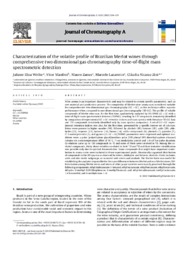Characterization of the volatile profile of Brazilian Merlot wines through comprehensive two dimensional gas chromatography time-of-flight mass spectrometric detection.
Characterization of the volatile profile of Brazilian Merlot wines through comprehensive two dimensional gas chromatography time-of-flight mass spectrometric detection.
Author(s): WELKE, J. E.; MANFROI, V.; ZANUS, M. C.; LAZZAROTTO, M.; ZINI, C. A.
Summary: Wine aroma is an important characteristic and may be related to certain specific parameters, such as raw material and production process. The complexity of Merlot wine aroma was considered suitable for comprehensive two-dimensional gas chromatography (GCGC), as this technique offers superior performance when compared to one-dimensional gas chromatography (1D-GC). The profile of volatile compounds of Merlot wine was, for the first time, qualitatively analyzed by HS-SPME-GCxGC with a time-of-flight mass spectrometric detector (TOFMS), resulting in 179 compounds tentatively identified by comparison of experimental GCxGC retention indices and mass spectra with literature 1D-GC data and 155 compounds tentatively identified only by mass spectra comparison. A set of GCGC experimental retention indices was also, for the first time, presented for a specific inverse set of columns. Esters were present in higher number (94), followed by alcohols (80), ketones (29), acids (29), aldehydes (23), terpenes (23), lactones (16), furans (14), sulfur compounds (9), phenols (7), pyrroles (5), C13-norisoprenoids (3), and pyrans (2). GCxGC/TOFMS parameters were improved and optimal conditions were: a polar (polyethylene glycol)/medium polar (50% phenyl 50% dimethyl arylene siloxane) column set, oven temperature offset of 10ºC, 7 s as modulation period and 1.4 s of hot pulse duration. Co-elutions came up to 138 compounds in 1D and some of them were resolved in 2D. Among the coeluted compounds, thirty-three volatiles co-eluted in both 1D and 2D and their tentative identification was possible only due to spectral deconvolution. Some compounds that might have important contribution to aroma notes were included in these superimposed peaks. Structurally organized distribution of compounds in the 2D space was observed for esters, aldehydes and ketones, alcohols, thiols, lactones, acids and also inside subgroups, as occurred with esters and alcohols. The Fischer Ratio was useful for establishing the analytes responsible for the main differences between Merlot and non-Merlot wines. Differentiation among Merlot wines and wines of other grape varieties were mainly perceived through the following components: ethyl dodecanoate, 1-hexanol, ethyl nonanoate, ethyl hexanoate, ethyl decanoate, dehydro-2-methyl-3(2H)thiophenone, 3-methyl butanoic acid, ethyl tetradecanoate, methyl octanoate, 1,4 butanediol, and 6-methyloctan-1-ol.
Publication year: 2012
Types of publication: Journal article
Unit: Embrapa Grape & Wine
Keywords: Análise química, Aroma, Brasil, Caracterização, Cromatografia Gasosa, Enologia, GCxGC/TOFMS, HS-SPME, Merlot, Perfil volátil, Tecnologia, Vinho
Observation
Some of Embrapa's publications are published as ePub files. To read them, use or download one of the following free software options to your computer or mobile device. Android: Google Play Books; IOS: iBooks; Windows and Linux: Calibre.
Access other publications
Access the Agricultural Research Database (BDPA) to consult Embrapa's full library collection and records.
Visit Embrapa Bookstore to purchase books and other publications sold by Embrapa.

